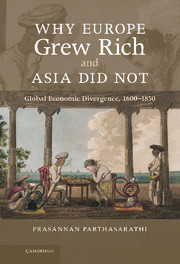Book contents
- Frontmatter
- Contents
- Figures
- Maps
- Tables
- Acknowledgments
- Abbreviations
- Maps
- Chapter 1 Introduction
- Part I Setting the stage: Europe and Asia before divergence
- Part II The divergence of Britain
- Part III The Indian path
- Chapter 7 Science and technology in India, 1600???1800
- Chapter 8 Modern industry in early nineteenth-century India
- Chapter 9 Conclusion
- Notes to the text
- Bibliography
- Index
Chapter 9 - Conclusion
Published online by Cambridge University Press: 07 September 2011
- Frontmatter
- Contents
- Figures
- Maps
- Tables
- Acknowledgments
- Abbreviations
- Maps
- Chapter 1 Introduction
- Part I Setting the stage: Europe and Asia before divergence
- Part II The divergence of Britain
- Part III The Indian path
- Chapter 7 Science and technology in India, 1600???1800
- Chapter 8 Modern industry in early nineteenth-century India
- Chapter 9 Conclusion
- Notes to the text
- Bibliography
- Index
Summary
The industrialization of Britain was a slow and protracted process, but by the early decades of the nineteenth century it was evident that the path of economic development in Western Europe had diverged from that of the Indian subcontinent. With the rise of the British cotton industry the major textile-exporting centers in the world migrated from India to Europe. The growing use of coal and steam revolutionized sources of power as well as transport and dramatically expanded the scale of production and output in the British Isles. Britain had given birth to a new industrial economy.
- Type
- Chapter
- Information
- Why Europe Grew Rich and Asia Did NotGlobal Economic Divergence, 1600–1850, pp. 263 - 269Publisher: Cambridge University PressPrint publication year: 2011

